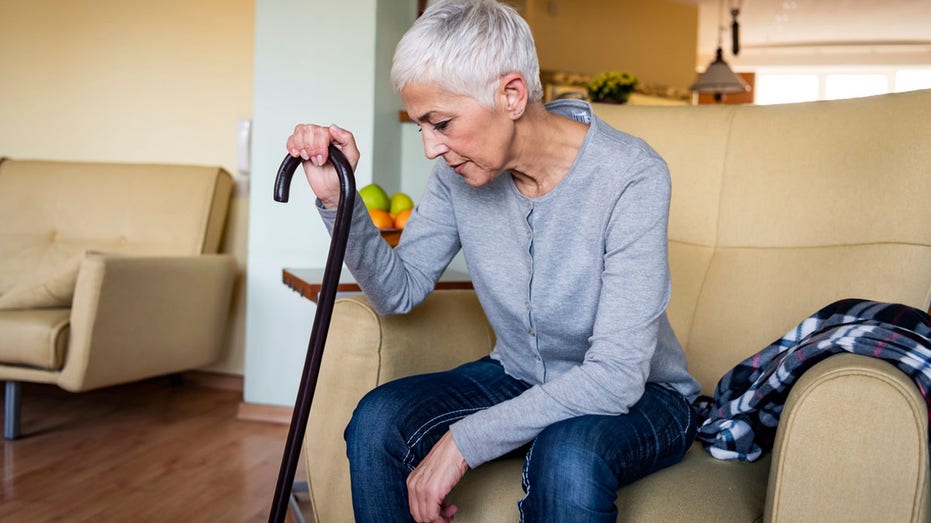Getting injured after a fall may be an early warning sign of dementia in older adults.
That’s according to a new study published in JAMA Network Open last month.
“This study quantifies a diagnostic pattern that geriatricians and primary care providers have recognized for quite some time – falls often precede a dementia diagnosis and older adults who experience a fall should undergo cognitive screening,” co-author Molly P. Jarman, PhD., deputy director of the Center for Surgery and Public Health at Brigham and Women’s Hospital and assistant professor of surgery at Harvard Medical School, told Fox News Digital.
PREVENT DANGEROUS FALLS AMONG OLDER ADULTS BY TAKING KEY STEPS
The Boston researchers analyzed U.S. Medicare claims data for more than two million adults age 66 and older who were diagnosed with a traumatic injury that resulted in an emergency department visit or hospital admission from 2014 to 2015.
Half of the injuries were the result of falls.
The researchers also reviewed follow-up data for at least one year after the injury, tracking how often the participants were diagnosed with dementia.
Among the patients who experienced a fall, 10.6% were diagnosed with some type of dementia within a year.
The study also analyzed data from older adults who experienced an injury from an event other than falling, such as a motor vehicle collision.
ALZHEIMER’S DISEASE: EARLY SIGNS AND SYMPTOMS YOU MAY SPOT IN YOURSELF OR A LOVED ONE
“Among the older adults with other types of injury, only 6.1% were subsequently diagnosed with dementia,” Jarman noted.
After accounting for variables that could potentially influence the results — such as demographics, the severity of injury and underlying medical issues — the patients with fall-related injuries were 20% more likely to be diagnosed with dementia compared to those with other types of injury.
Approximately one in 10 U.S. adults over the age of 65 has dementia, past research shows.
One of the main limitations of the research is that it only looked at records back in time – so it’s unclear whether falls are causing dementia or if older adults who are at risk for dementia are more likely to experience a fall, according to the researchers.
“We believe the latter is most likely – older adults with mild cognitive impairment or undiagnosed dementia may be more likely to experience a fall due to changes in their gait and balance,” Jarman told Fox News Digital.
“The fall then leads them to have more interaction with the health care system, which results in their dementia diagnosis.”
Michael S. Okun, M.D., medical advisor to the Parkinson’s Foundation and director of the Fixel Institute for Neurological Diseases at the University of Florida Health, confirmed that when older adults start falling, this could be a potential warning symptom.
He was not part of the study.
AGING MAY SPEED UP AFTER DEATH OF A LOVED ONE, STUDY FINDS: ‘MAJOR LIFE STRESSOR’
“When, for example, we hear chest pain, we think heart attack — and similarly, when we hear falling, we should be thinking about dementia risk,” Okun told Fox News Digital.
“A good rule of thumb would be to initiate an examination of thinking ability as soon as possible for new onset falling.”
It is not routine practice to perform cognitive screening for older adults who experience a fall, according to Jarman.
“We hope that the results of our study will encourage clinicians to monitor the cognitive health of older adults who fall,” she said.
Clinicians could start screening during the initial hospitalization after a fall, Jarman suggested, and the patient’s primary care physician or a geriatrician could then perform a follow-up screening.
“The notion that an elderly person needs only physical therapy after a fall is wrong,” Okun added.
“We should be teaching folks the value of examining brain function in fallers.”
Falls are the leading cause of injury for adults 65 years and older, according to the Centers for Disease Control and Prevention (CDC).
An older adult falls about every second of every day, with one in four reporting falling each year, the same source states.
AGING SLOWDOWN COULD BE SURPRISE BENEFIT OF EXISTING MEDICATION, RESEARCH SHOWS
“Falls can lead to serious, even life-threatening, injuries in older adults,” Jarman cautioned.
“Patients who fall are at a high risk of losing independence.”
Most falls occur because of a combination of risk factors — and the more risk factors someone has, the greater the likelihood of a fall, the CDC warns.
The agency recommends four practices to prevent falls.
First, have an honest discussion with your health care provider about your personal risk of falls, the CDC recommends.
CLICK HERE TO SIGN UP FOR OUR HEALTH NEWSLETTER
That also includes reviewing all medications if there is any chance they could make you feel sleepy or dizzy.
Regular exercise, such as Tai Chi, helps to improve balance and make your legs stronger to reduce your chances of falling.
Experts recommend asking your doctor which regimen is best for you.
The CDC recommends getting your eyes and feet checked every year and talking to your health provider about proper footwear.
Some people may have undiagnosed vision problems, like glaucoma or cataracts, which can increase the risk of falling, the same source noted.
Lastly, the agency recommends completing an inspection to make sure your home is safe.
This includes removing clutter, using double-sided tape to keep rugs from slipping, placing items in cabinets that can be easily reached without a step stool, installing grab bars next to and inside tubs, and placing non-slip mats on shower floors.
For more Health articles, visit www.foxnews.com/health
People should also consider using nightlights to help guide them to the bathroom and ensuring that the entire home has adequate lighting, the CDC advised.
Source
